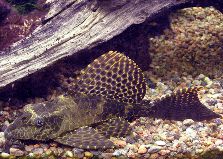Sailfin Pleco
(Pterygoplichthys Gibbiceps)
Alternate Names:
Leopard Pleco
 Sailfin Pleco (Pterygoplichthys Gibbiceps) |
Size: Can grow to 18 inches Temp Range: 73°F to 81°F pH Level: 6.5 to 7.8 Lifespan: 23 to 35 years Tank Size: 150 gallons Diet: Pellet, Flake, Vegetable Difficulty: Moderate to Hard |
Geographic History
These impressive fish come from the Orinco and Amazon River basins in Brazil, Ecuador, Peru, and Venezuela. They are found in sluggish, slow river waters and move to flooded areas during the wet season. They love to burrow into muddy banks to make their homes.
Enviornment
These large fish produce a great deal of waste and require excellent aquarium filtration. They will need a large tank with lots of space to thrive. Provide them with some big pieces of driftwood and a bunch of hiding spots.
Compatibility
Sailfin Plecos are tough customers. The larger adults are very territorial and will attack other Plecos. This robust armored catfish can difinitely hold its own against aggressive Cichlids when it is full grown.
Because of the huge bio-load that these fish will put on your aquarium system and their level of aggressiveness, you should probably only have one of these living room monsters in your aquarium. They have the potential of being excellent community aquarium Plecos, but small fin nipping fish will go after their massive dorsal fin.
Sexing
These fish can only be sexed by looking at the genital papilla on their bellies. Males will have a small, thick stump that sticks out. Females papilla are much smaller and lay flat. These features are only noticable on mature adult fish.
Behavior
These nocturnal fish will spend most of the day hiding under driftwood or behind a heavily planted area. Larger adults may be less timid and just sit on top of driftwood.
At night they come out and scavenge for bits of food and algae. They will be most often seen, especially as juveniles, as a shadow hanging off the glass or a strange hump on a piece of aquarium decor.
When they are young, they are very handy for keeping algae off of your aquarium glass. As these fish age, they tend to eat less algae. You will have to supplement their diets with sinking algae wafers and raw vegetables to maintain their health.
Sometimes you will see these fish shoot quickly to the surface and then back into hiding. They gulp air to aid in their bouyancy. Be sure that you have a tight hood because they will sometimes misjudge the distance and jump out of the water.
Breeding
Sailfin Plecos are not easily bred in home aquariums. You will need a very large breeding tank with a single direction current to simulate a river bottom. Excellent water quality is a requirement. This means that the breeding tank must have an strong and established filtration system.
Provide many hiding spots for them to spawn in. PVC tubes or clay pipes work very well for this purpose. They will need to be eight to ten inches wide and over a two feet long. These pipes should be large enough for the male to fit his entire body inside and have a little room all the way around.
When spawning happens, the female will lay her eggs in the tube. This usually happens at night. After the eggs are laid, remove the female because she will have nothing more to do with the spawning process. The male will tend the eggs by fanning water over them until they hatch. This takes about nine days.
Having a bare bottom tank will help the fry develop and be healthy. They will attach to the bottom and feed on algae growing there. They will also have an easier time eating crushed flake food and baby brine shrimp that land on the bottom.
You should maintain a very high level of water quality while the fry grow into juveniles. The male parent will deposit a good amount of waste and so will the fry as they grow. Do daily 10% water changes to accomplish this. Be careful not to suck fry out of the aquarium with the old water.
For more information, go to Wikipedia's Sailfin Pleco page.





